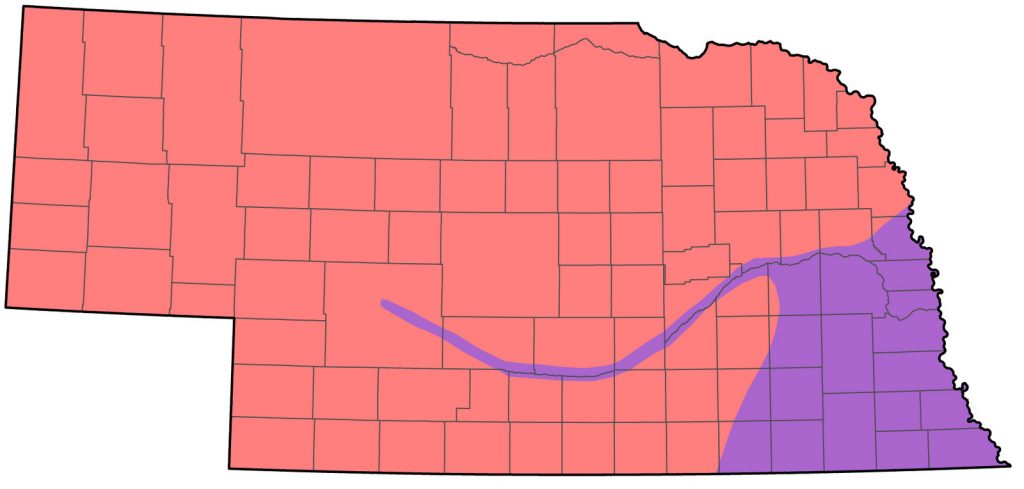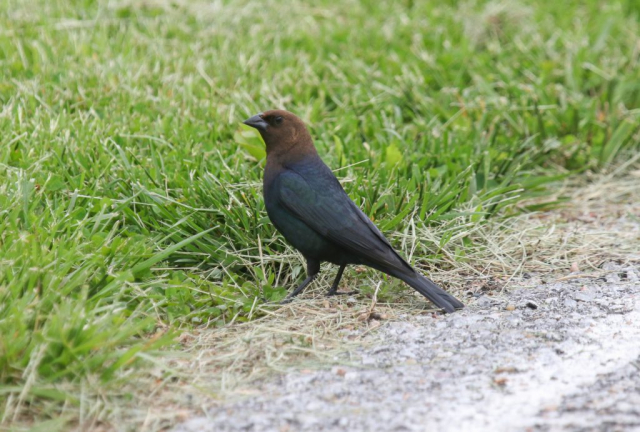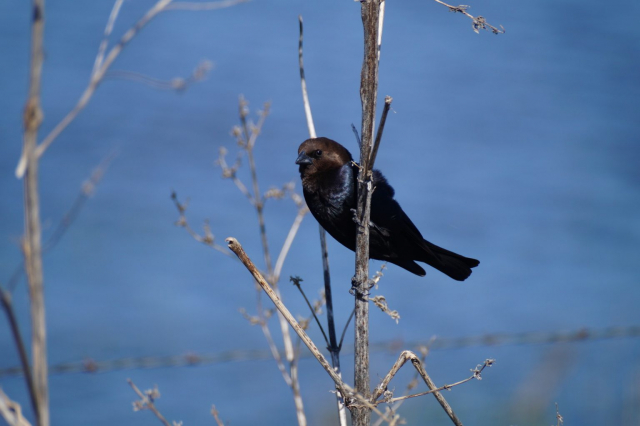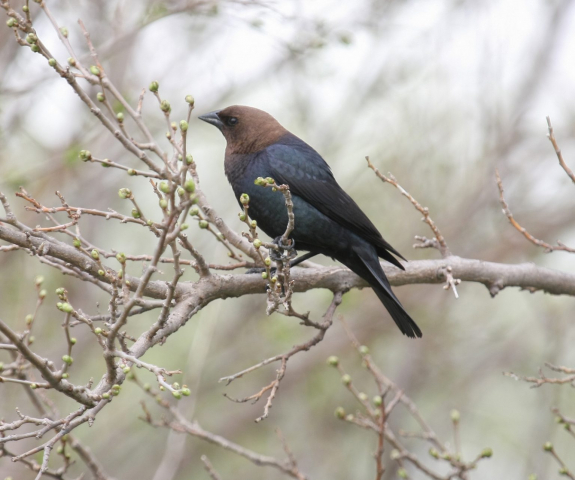Molothrus ater ATER, M. A. Artemisiae
Status: Abundant regular spring and fall migrant statewide. Common regular breeder statewide. Rare regular winter visitor south and east, rare casual elsewhere.

Documentation: Specimen: UNSM ZM11867, 10 Oct 1889, Lincoln, Lancaster Co.
Taxonomy: Three subspecies are recognized (AviList 2025): artemisiae of interior western Canada and western US, ater of the central and east-central US, wintering to the Gulf Coast, Florida, and southern Mexico, and obscurus of coastal Alaska, western Canada, western US, and northwestern Mexico.
The ranges outlined by AOU (1957) suggest that ater breeds in eastern Nebraska and artemisiae in the west, although the limits of the respective breeding ranges are unknown. Most Nebraska breeders are probably intergrades. Migrants over most of the state are likely to be artemisiae, as ater apparently occurs only in southeastern Nebraska. Obscurus may occur in western Nebraska most likely as a fall migrant.
Pyle (2025) synonymized artemisiae and obscurus with ater based on their not meeting the generally accepted 75% rule for subspecies diagnosability.
Spring: Mar 11, 11, 12 <<<>>> summer (north); Apr 11, 11, 11 <<<>>> summer (west)
Earlier dates in the north are 6 Mar 2014 Loup Co, and 8 Mar 2013 Custer Co.
Earlier dates in the west (away from the North Platte River Valley) are 2 Apr 2019 Chadron SP, Dawes Co, 3 Apr 2025 Oliver Reservoir, Kimball Co, 6 Apr 2024 Road 181, Garden Co, and 9 Apr 2021 Crescent Lake NWR, Garden Co.
Migration is detectable in the north in Mar away from the core wintering area in the south and east; by late Apr the entire state is occupied except the northern Panhandle, which is occupied in May. Early flocks are mostly males; a flock near Peru, Nemaha Co 29 Mar 2009 had 121 males and seven females.
- High counts: 5000 in Hall Co 13 Mar 2016, 1000 in Lincoln Co 21 Mar 2021, 1000 in Hall Co 18 Mar 2025, 750 in Clay Co 22 Mar 2009, 700 at Cub Creek Reservoir, Jefferson Co 15 Apr 2022, and 686 in Hall Co 11 May 2002. “Thousands” were in Nuckolls Co 20 Apr 2007.
Summer: Brown-headed Cowbird breeds statewide in moderate numbers, although BBS data suggest higher abundance in the east. BBS trend analysis (Sauer et al 2020) shows an annual change in abundance of – 0.04 (95% C.I.: – 0.57, 0.48) statewide 1966-2019, indicating numbers have remained relatively stable during the period.This species is a host parasite (Lowther 2020) and probably associates with the same host species as in Kansas, where some 121 have been reported (Lowther 1988). Hosts are generally from the following groups (Bent 1968): flycatchers, vireos, warblers, and finches. Mollhoff (2016) presented data for the breeding bird atlas period 2006-2011 showing that 28 host species were reported for Nebraska, most commonly Western Meadowlark, Bobolink, Grasshopper Sparrow, and Dickcissel. This list was updated by Mollhoff (2022), showing 52 species parasitized, most commonly Bobolink, 58% of nests examined, and Indigo Bunting, 56%; 10 additional species had rates above 30%. Breeding Brown-headed Cowbirds have adapted to a wide range of habitat types from grassland to woodland, including, in the northwest, forested canyons (Rosche 1982). Although preferred habitat is edge and thickets (Johnsgard 1980), probably no forest in Nebraska is extensive enough that this species does not penetrate its interior; forest fragmentation has allowed this species access to previously unattainable interior forest species (Dobkin 1994).
An often-asked question is how cowbird nestlings and new fledglings assume cowbird identity and avoid imprinting on their host parents; an intriguing (and amusing) explanation involves older nestlings leaving the nest overnight to roost in cowbird habitat (Louder et al 2015).
- Breeding phenology:
Courtship: 30 Mar-15 Apr - Copulation: 1 May-29 Jun
- Eggs: 21 Apr- 29 Aug (Mollhoff 2022)
- Nestlings: 23 May
Fledglings: 31 May-1 Sep
Fall summer <<<>>> Oct 26, 28, 30 (north, west); summer <<<>>> Jan 2, 4, 5 (south, east)
Winter dates (Nov-Feb) in the north and west are summarized in Winter.
Flocking of young birds to roosts begins as early as 18 Jun (Brown et al 1996), and sizeable flocks appear Jul-Aug statewide, including adults, such as the 440 along 2.3 miles of Stegall Road, Scotts Bluff Co 18 Jul 2024, and 320 in Cuming Co 31 Jul 2021. In the west, many adults disappear after the breeding season ends in Jul, while young birds linger into Sep; virtually all birds depart the west during Sep (Rosche 1994), and in the north by mid-Oct.
A huge mixed species blackbird flock lingering at Platte River SP, Cass Co 3 Jan 2025 yielded an estimate of 1000 cowbirds, and a flock of 75 was in Buffalo Co 29 Dec 2011.
CBC data indicate that a few birds linger through Dec in the northeast and westward in the Platte River Valley. There are several CBC records at Lake McConaughy, Keith Co; on five counts in the period 27 Dec-2 Jan, best totals were 150 on 31 Dec 2011 and a surprising 400 on 29 Dec 2012. At northeastern count locations, Beaver Valley in Boone Co, Calamus-Loup mostly in Loup Co, Ponca SP in Dixon Co, and Norfolk in Cuming Co, best counts were 212 at Norfolk 17 Dec 2011 and 30 at Beaver Valley 1 Dec 2007. A flock of 100 was on the Ames, Dodge Co CBC 17 Dec 2019. Most of these west-central and northeastern CBCs report fewer than 10 cowbirds, if any, in a given year, although the North Platte CBC, Lincoln Co, had a count high 12 on 17 Dec 2024.
- High counts: 12,000 at Funk WPA, Phelps Co 18 Oct 1996, 10,000 near Axtell, Kearney Co 17 Oct 2023, 5000 in Lancaster Co 1 Sep 2006, “several thousand” between Odessa and Funk WPA 5 Sep 1999, 3000 in Lancaster Co 21 Oct 2005, and 2500 in Seward Co 4 Sep 2009.
Winter: Overwintering is rare, especially in the west; 2-6 birds wintering 2001-2002 at a feedlot east of Gering, Scotts Bluff Co is perhaps the only such record. Most winter (Dec-Feb) reports are of small numbers with wintering flocks of Red-winged Blackbirds and European Starlings around livestock lots in the west, south, and east; in the north there are only these records (eBird.org, accessed Mar 2024): 15 Dec 2023 (2) Keya Paha Co, 22 Dec 2019 Boyd Co, 1 Feb 2025 Antelope Co, 6 Feb 2024 (2) Knox Co, 10 Feb 2023 (4) Howard Co, and 18 Feb 2024 Sherman Co.
Images
Abbreviations
BBS: Breeding Bird Survey
CBC: Christmas Bird Count
NWR: National Wildlife Refuge
SP: State Park
UNSM: University of Nebraska State Museum
WPA: Waterfowl Production Area (Federal)
Literature Cited
American Ornithologists’ Union [AOU]. 1957. The AOU Check-list of North American birds, 5th ed. Port City Press, Baltimore, Maryland, USA.
AviList Core Team, 2025. AviList: The Global Avian Checklist, v2025. https://doi.org/10.2173/avilist.v2025.
Bent, A.C. 1968. Life histories of North American Cardinals, Grosbeaks, Buntings, Towhees, Finches, Sparrows, and allies. Bulletin of the United States National Museum 237. Dover Publications Reprint 1968, New York, New York, USA.
Brown, C.R., M.B. Brown, P.A. Johnsgard, J. Kren, and W.C. Scharf. 1996. Birds of the Cedar Point Biological Station area, Keith and Garden Counties, Nebraska: Seasonal occurrence and breeding data. Transactions of the Nebraska Academy of Sciences 23: 91-108.
Dobkin, D.S. 1994. Conservation and management of neotropical migrant landbirds in the northern Rockies and Great Plains. University of Idaho Press, Moscow, Idaho, USA.
Johnsgard, P. A. 1980. A preliminary list of the birds of Nebraska and adjacent Great Plains states. Published by the author, University of Nebraska, Lincoln, USA.
Louder, M.I.M, M.P. Ward, W.M. Schelsky, M.E. Hauber, and J.P. Hoover. 2015. Out on their own: a test of adult-assisted dispersal in fledgling brood parasites reveals solitary departures from hosts. Animal Behaviour 110: 29 DOI: 10.1016/j.anbehav.2015.09.009.
Lowther, P.E. 1988. Kansas cowbird hosts, a catalogue update. Kansas Ornithological Society Bulletin 39: 36-37.
Lowther, P.E. 2020. Brown-headed Cowbird (Molothrus ater), version 1.0. In Birds of the World (A. F. Poole and F. B. Gill, Editors). Cornell Lab of Ornithology, Ithaca, NY, USA. https://doi.org/10.2173/bow.bnhcow.01.
Mollhoff, W.J. 2016. The Second Nebraska Breeding Bird Atlas. Bull. Univ. Nebraska State Museum Vol 29. University of Nebraska State Museum, Lincoln, Nebraska, USA.
Mollhoff, W.J. 2022. Nest records of Nebraska birds. Nebraska Ornithologists’ Union Occasional Paper Number 9.
Pyle, P. 2025. A Practical Subspecies Taxonomy for North American Birds. North American Birds 76(1).
Rosche, R.C. 1982. Birds of northwestern Nebraska and southwestern South Dakota, an annotated checklist. Cottonwood Press, Crawford, Nebraska, USA.
Rosche, R.C. 1994. Birds of the Lake McConaughy area and the North Platte River valley, Nebraska. Published by the author, Chadron, Nebraska, USA.
Sauer, J.R., W.A. Link and J.E. Hines. 2020. The North American Breeding Bird Sruvey – Analysis Results 1966-2019. U.S. Geological Survey data release, https://doi.org/10.5066/P96A7675, accessed 27 Jul 2023.
Recommended Citation
Silcock, W.R., and J.G. Jorgensen. 2025. Brown-headed Cowbird (Molothrus ater). In Birds of Nebraska — Online. www.BirdsofNebraska.org
Birds of Nebraska – Online
Updated 9 Sep 2025



